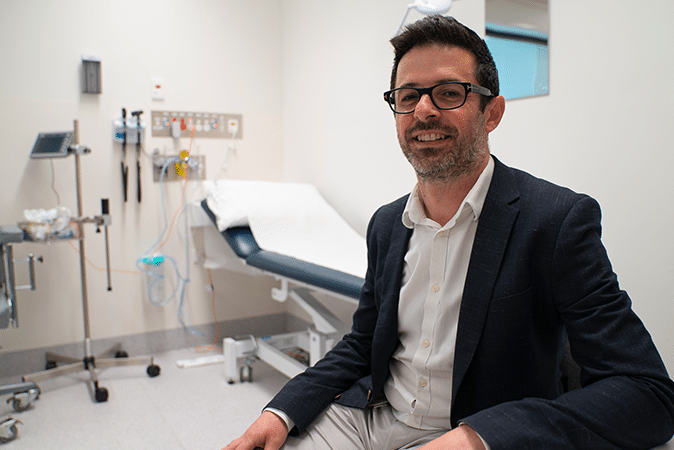Breast Cancer Types
Breast cancer is the most commonly diagnosed cancer in Australia. It occurs when abnormal or damaged cells grow in an uncontrolled manner and a tumour is formed. Breast cancer can occur in both women and men, although it is less common for it to occur in men. In Australia the risk of being diagnosed with breast cancer by age 85 is 1 in 7 for women and 1 in 675 for men.
Breast cancer is not just one disease, but several. There are a number of different breast cancer subtypes and treatments are becoming increasingly personalised for patients.
You can learn about the signs and symptoms of breast cancer here.
You can learn about breast cancer prevention and how to reduce your risk of breast cancer here.
Non-Invasive Breast Conditions
-
Ductal Carcinoma In SituDuctal carcinoma in situ or DCIS is a non-invasive breast condition which affects around 1,200 women a year in Australia. DCIS is the name for abnormal changes in the cells in the milk ducts of the breast.Although these abnormal changes have the potential to turn into invasive cancer cells, it is not breast cancer as we more commonly understand it. A woman cannot die from DCIS as the abnormal cells are contained within the milk ducts.DCIS cannot usually be felt but is found on a mammogram or ultrasound. If not treated it can develop into a more serious, invasive breast cancer. Treatment of DCIS usually involves breast surgery and radiotherapy, and occasionally includes surgery to remove lymph nodes and hormonal therapies.
-
Lobular Carcinoma In Situ
Lobular carcinoma in situ or LCIS is a non-invasive breast condition. LCIS is the name for abnormal cells that are contained to the lobules (milk glands) of the breast.
Like DCIS, although these abnormal changes can turn into invasive cancer cells, it is not breast cancer as we more commonly understand it. A woman cannot die from LCIS as the cells are contained to the lobules of the breast.
LCIS cannot usually be felt but is found in a mammogram or when a biopsy is taken for another reason. LCIS does not require treatment if there are no other abnormal changes to the breast. However, a woman with LCIS should be carefully monitored as having LCIS increases the chance of developing breast cancer in future.
Invasive Breast Cancers – Histological Subtypes
-
Invasive Ductal Carcinoma
Invasive ductal carcinoma is a broad term used to classify cancer that began growing in a milk duct and has invaded the fibrous or fatty tissue of the breast outside the duct. Invasive ductal carcinoma accounts for around 80 per cent of all breast cancers diagnosed.
-
Invasive Lobular Carcinoma
Invasive lobular carcinoma the other major histological subtype: a breast cancer that begins in the lobules (milk glands) of the breast, and has spread beyond the lobule, potentially spreading to the lymph nodes and other parts of the body. Typically, invasive lobular carcinoma tumors are associated with a good prognosis, being low grade and oestrogen receptor positive. However, the tumour can be highly metastatic.
-
Paget’s Disease Of The Nipple
Paget’s disease of the nipple is a rare form of breast cancer that affects the nipple and the area around the nipple (the areola). It is commonly associated with an invasive cancer elsewhere in the breast. Around two of every 100 cases of breast cancer involve Paget’s disease of the nipple.
The main sign of Paget’s disease of the nipple is a change in the nipple and/or areola. Treatment can include breast surgery and radiotherapy.
-
Inflammatory Breast Cancer
Inflammatory breast cancer is a rare form of breast cancer that affects the lymphatic vessels in the skin of the breast. This type of breast cancer does not present as a lump but rather a redness or rash in appearance, as a result of the lymphatic vessels becoming blocked and the breast becomes red and swollen, similar to an infection. Most women with inflammatory breast cancer will have a combination of treatments that can include surgery, chemotherapy, radiotherapy, hormonal therapies and targeted therapies.
Invasive Breast Cancers – Treatment Targets
-
HER2 Positive Breast Cancer
HER2 positive breast cancer is any type of breast cancer that tests positive for a protein called human epidermal growth factor receptor 2 (HER2). HER2 positive breast cancer is a more aggressive form of breast cancer compared with HER2 negative disease.
HER2 positive breast cancer is treated using a HER2 targeted therapy. The most common HER2 positive targeted therapy available in Australia and New Zealand is trastuzumab (Herceptin). Herceptin was found to significantly reduce breast cancer returning, as reported in the Breast Cancer Trials HERA clinical trial.
For women with HER2 positive early breast cancer, the current recommendation is to give trastuzumab at the same time as chemotherapy, either before or after breast cancer surgery.
For women with HER2 positive metastatic breast cancer, trastuzumab may be given on its own or with other treatments and will continue so long as the benefit to the patient outweighs the side effects.
-
Triple Negative Breast Cancer
Triple negative breast cancer is breast cancer that tests negative for all three receptors – oestrogen, progesterone and HER2. Triple negative breast cancer is a more aggressive cancer that usually occurs at an earlier age. It has a greater chance of developing into a metastatic stage and has poorer clinical outcomes as shown by higher relapse rates and lower survival rates.
Standard treatment of triple negative breast cancer typically consists of surgery, chemotherapy and usually a course of radiotherapy. Often chemotherapy treatment is given prior to breast surgery (neoadjuvant chemotherapy) as it is effective in reducing the size of the breast cancer while providing useful information about the effectiveness of the treatment being given.
You can learn more about triple negative breast cancer here.
Breast Cancer Stages
-
Early Breast Cancer
Early breast cancer is an invasive breast cancer that is contained in the breast and may or may not have spread to lymph nodes in the breast or armpit. The aim of treatment for early breast cancer is to remove the breast cancer and any cancer cells that may be left in the breast, armpit or other parts of the body but cannot be detected. Treatment can involve radiotherapy, breast surgery, chemotherapy, hormonal therapies and targeted therapies.
-
Locally Advanced Breast Cancer
Locally advanced breast cancer is an invasive breast cancer that is large or has spread to areas near the breast, such as the chest wall. However, there are no signs the cancer has spread beyond the breast region or to other parts of the body.
Signs of locally advanced breast cancer can include a lump in the breast or armpit that doesn’t move freely but feels attached to the chest wall, a lump at the base of the neck, ulcers on the breast, dimpled skin that looks like an orange peel or a large red, swollen breast. Treatment for locally advanced breast cancer will usually involve a combination of breast surgery, chemotherapy, radiotherapy, targeted therapies or hormonal therapies.
-
Metastatic Breast Cancer
Metastatic breast cancer, also known as advanced, secondary or stage four breast cancer, is breast cancer which has spread to other parts of the body such as the bones, liver or lungs. Many people who are diagnosed with metastatic breast cancer have been diagnosed with breast cancer before. However, for some it can be the first diagnosis of breast cancer.
Metastatic breast cancer occurs when cancer cells break away from the cancer in the breast and move via blood vessels or lymphatic vessels and form a new cancer growth in other parts of the body.
Every metastatic breast cancer diagnosis is different and will therefore require different treatments. Despite the cancer growths being in other organs such as the lung, it is still called ‘breast cancer’ and is treated as breast cancer. The aim of treating metastatic breast cancer is to control the growth and spread of the cancer, to relieve symptoms and improve or maintain quality of life. Treatment options will depend on what is most likely to control the cancer and what side effects the patient can cope with. Treatment for metastatic breast cancer can include hormonal therapy, chemotherapy, targeted therapy, radiotherapy and surgery.
If you have any concerns regarding your treatment or diagnosis, speak with you treating physician.
You can learn more about open Breast Cancer Trials clinical trials here.
QUICK ACCESS
Support Us
Help us to change lives through breast cancer clinical trials research



